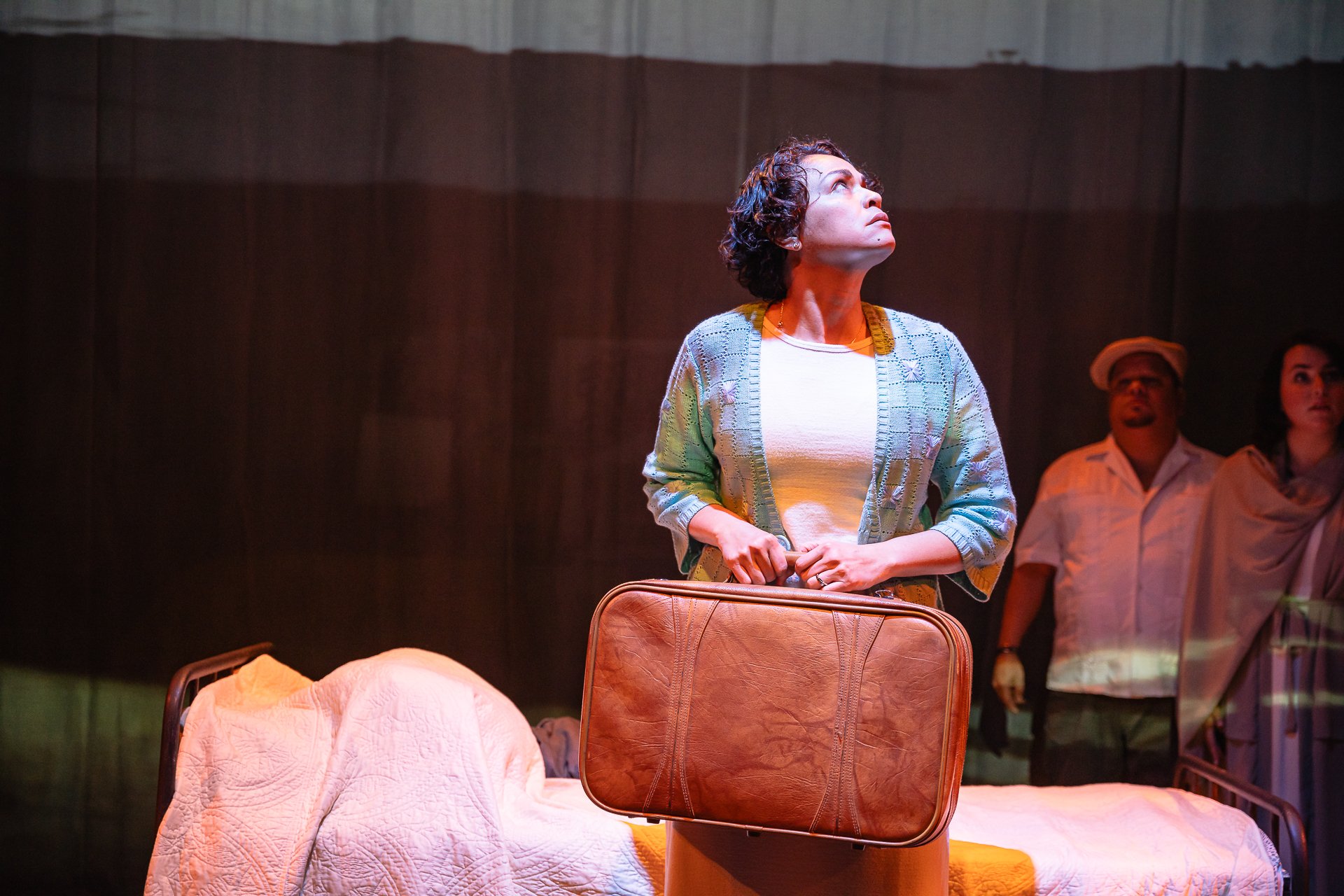PAFA digitizes 5,000 archives of African-American sculptor John Rhoden
Some of the award-winning artists' sculptures will be distributed to museum collections around the country.
BY NEMESIS MORA ON FEBRUARY 27, 2024
Monumental reclining female nude with three heads, on display in the exhibition 'Determined to Be: The Sculpture of John Rhoden' at PAFA. (Némesis Mora for ¡Presente! Media)
In a remodeled four-story building at 23 Cranberry Street in Brooklyn, New York, 20th-century African-American sculptor John Rhoden lived with his wife, Richanda Rhoden, from the 1960s until the last year of his life, 2001. The 8,000-square-foot home served as his studio and an unofficial art gallery where Rhoden kept his collection of nearly 300 bronze, stone, and wood sculptures. The works, some as tall as 10 feet, were prominently displayed in the building’s grand window, which often served as a point for Brooklyn Heights discussions. The Rhodens' home was a community gathering place where the couple enjoyed making art accessible by hosting tours for friends, neighbors, and students and offering art classes and workshops.
"Getting to walk through the house was really incredible because then I got a sense of how all of that sculpture lived in the space," said Dr. Brittany Webb in an interview with Presente! Media. She is the Evelyn and Will Kaplan Curator of Twentieth Century Art and the curator of the John Rhoden collection at the Pennsylvania Academy of the Fine Arts (PAFA).
"It was mind-blowing,” Webb continued, “Because I thought: Oh, this is so much bronze sculpture that was in one person's house."
To continue the legacy of the award-winning sculptor and the first African American visual arts fellow at the American Academy in Rome, PAFA, took custody of more than 275 sculptures from his Cranberry Street home in 2017, as well as personal papers, photographs, and color slides that highlight Rhoden's extensive travels abroad, visiting three continents and more than 20 countries. PAFA will keep only 25 of the sculptures, and the remaining will be distributed to museum collections around the country.
Dr. Brittany Webb, curator of John Rhoden collection at PAFA. (Courtesy: Lori Waselchuk / PAFA)
Now, people from anywhere in the world can access Rhoden's life and work online thanks to PAFA’s work to digitize 5,000 objects from Rhoden’s career, funded by a 2018 National Endowment for the Humanities grant.
At PAFA's museum in Philadelphia, the largest and first-ever retrospective exhibition of his work, 'Determined to Be: The Sculpture of John Rhoden', remains on view through April 7. Afterward, it will move to the Birmingham Museum of Art in Alabama for the month of October. The exhibition features 70 small- and large-scale sculptures that pursue the aesthetics of abstraction and figurativism. Although just a sample, the works illustrate the significance of his wife, Richenda, as his muse, capturing the essence of sensuality in female forms, and reflecting the indigenous influences from his experiences as a world-traveling artist.
"I'm kind of surprised about how prolific he was," said Mike Sparrow, one of the participants in Dr. Webb's exhibition tour at PAFA museum on Saturday, February 10.
In the words of Marguerite Anglin, also a tour participant and public art director of the Office of Arts, Culture, and the Creative Economy for the City of Philadelphia, the Rhoden exhibit "blew her mind." "It's a beautiful collection," she continued.
Even the assistant director of public programs at PAFA, Lori Waselchuk, was moved by Rhoden's work during the tour. "Rhoden was an amazing artist and a brilliant human being.” PAFA's Rhoden Arts Center, she said was dedicated to John and Richanda Rhoden. “The works are absolutely profoundly moving," Waselchuk told ¡Presente Media!
PAFA is currently featuring an extensive schedule of events related to Rhoden's work. On February 24, archivist Kelin Baldridge Smallwood will lead a behind-the-scenes tour and conversation about the year-long project of processing, preserving, and digitizing the John Rhoden Collection. In March, two events will be related to the female women's bodies in the arts. One will be a conversation with the writer Anna Badkhen and poet Airea D. Matthews on March 9. The other is a conceptual game by Misty Sol to reflect on the body and the power dynamic between the observer and the observed while deepening our understanding of the ideas presented in the artworks in the Rhoden collection.
PAFA's ongoing work on Rhoden's life and art is part of its commitment to preserve and promote the sculptor's work, which, for some, is under-recognized in American modern art history.
"The [PAFA] goal is to make sure that Rhoden's work is accessible around the country," Waselchuk said.
For a complete list of events, click here.
THE DIGITIZATION PROCESS
On Saturday, February 10, a symposium was also held at PAFA to launch the 'Determined to Be: The Sculpture of John Rhoden' exhibition catalog.
From left to right: Hannah 'Han' McCoy, Dr. Katelyn D. Crawford, Dr. Brittany Webb, Kelin Baldridge Smallwood, and Dr. Greg Barnhisel. (Courtesy: Lori Waselchuk / PAFA)
As part of the symposium, the catalog writers participated in a roundtable, where University of Pennsylvania's Kislak Center for Special Collections, Rare Books and Manuscripts processing archivist Kelin Baldridge Smallwood explained the meticulous work she undertook to organize and describe Rhoden's archives. As she recounts in her essay 'Archivist's Statement,' which is part of the catalog, Rhoden's papers measured 22 linear feet, meaning that the containers, lined up side by side, were 22 feet long.
Among the papers they researched and archived were correspondences, contracts, notes, ephemera, exhibition catalogs, sketchbooks, artwork, manuscripts, and printed and photographic material dating mainly to between 1938 and 1992.
"When they came to us, John had been dead for almost 20 years. So if there was a system of organization that he had given to his papers, it was long gone," Baldridge Smallwood said at the roundtable. "They were a mess, which, as an archivist, I really enjoy. That means I have a lot of work to do."
Rhoden’s life was detailed and intriguing. For instance, by 1955, the U.S. State Department asked Rhoden to be one of its "art specialists", a relatively new position at the time. Rhoden had previously enlisted as a private in the U.S. Army Reserve Corps in 1942. As a private, he continued his work as an artist while offering art classes.
Dr. Greg Garnhisel, an English professor at Duquesne University in Pittsburgh, researched Rhoden's papers as a Cold War cultural diplomat. According to Dr. Garnhisel, The Department of State and the USIA wanted African American voices in their diplomacy programs in response to Soviet communist propaganda exposing U.S. discrimination against Black Americans. As an "art specialist," Rhoden's job was to "go abroad to discuss [his] work in sculpture by giving lectures, informal talks, and generally ‘talking shop’ with colleagues and interested persons." Between 1955 and 1956, Rhoden toured his works throughout Iceland, Germany, Finland, Norway, Italy, and France.
The Rhoden Curatorial Assistant at PAFA, Hanna McCoy, was in charge of writing the chronology of Rhoden's life for the catalog and was able to complement her work by traveling to the American Academy in Rome to research Rhoden's papers. Beyond his art, the archives are, for McCoy, a way to delve into the most particular moments in Rhoden's life.
"The archives reveal not only his artistic practices but really who John was as a person. I found him to be very engaging," said McCoy during the roundtable.
Dr. Webb also served as a writer for the catalog, which focused on Rhoden's artistic life from his native Birmingham, Alabama, to Brooklyn. As part of her research process, she used the Rhoden archives at the Smithsonian American Art Museum, oral histories, newspaper clippings, family histories, and memoirs & biographies.
The William Cary Hulsey Curator of American Art at the Birmingham Museum of Art, Dr. Katelyn D. Crawford, shared parts of her essay on John Rhoden's southern art community and the wave of racism that was threatening its surroundings, especially in a metal town like Birmingham, where the iron and steel industry was booming and depended on the skilled labor of Black men.
Dr. Crawford said, "Rhoden also became an adept craftsperson, mastering the bronze-casting work necessary to complete his sculpture in the foundry."
For online access to the Rhodens archives, click here.
The Slave Ship by John Rhoden. (Némesis Mora for ¡Presente! Media)
THE CATALOG SYMPOSIUM
Photographer Sahar Coston-Hardy and graffer and lighting programmer Ed DiJoseph discussed the process of photographing and editing photos of Rhoden's sculptures for the catalog. As they shared with the audience, it was challenging due to the weight, size, and lighting details, especially those featuring the female figure.
Dr. Renée Ater, an educator for over twenty years and a visiting professor in Africana Studies at Brown University, led a session on the "visceral" bronze sculpture, The Slave Ship. This sculpture takes the form of a ship with women and men chained and enslaved on a long voyage of agony and injustice. One hangs from the beam, with his feet pointing into the mortal emptiness that represents the sea.
"Museums are not just to entertain; they are also to discomfort," said Dr. Ater.
Acclaimed and award-winning scholar Dr. Imani Perry was responsible for the keynote address. Dr. Perry is an interdisciplinary scholar and writer giving fresh context to African American social conditions and experiences along dimensions of race, gender, and politics.
In a similar vein to Dr. Crawford, Dr. Perry offered a perspective on the significance of Rhoden's 1934 education at Industrial High School (now A.H. Parker High School), which, Dr. Perry said, “had the distinction of being the largest Negro high school in the United States.”
Dr. Imani Perry, keynote address. (Courtesy: Lori Waselchuk / PAFA)
"I think it is essential for Rhoden to be understood as a product of a Black southern academic tradition," Dr. Perry said in her closing remarks.
Dr. Perry also elaborated on the straightforward jazz influences in Rhoden's sculptures and the rhythmic nature of his work.
WHO WAS RHODEN?
John Rhoden was born in 1916 in Birmingham, Alabama, where the exhibition 'Determined to Be: The Sculpture of John Rhoden' will travel soon.
Archival photo of John Rhoden. (Courtesy PAFA)
After graduating from Industrial High School, he was awarded a scholarship to study at Talladega College.
As Dr. Webb writes in her catalog essay, when Rhoden got to New York in 1937, he encountered a bright cultural world in the museums and art schools, combined with the influences of the Harlem Renaissance, positively different from his experience in Birmingham.
“I used to tell the people that I wanted to be a sculptor. In the first place, even teachers had no idea exactly what it was. I mean, nobody could encourage me,” reads part of Dr. Webb’s essay after transcribing an oral interview of Rhoden in 1968.
In New York, Rhoden met sculptor Augusta Savage, who introduced him to the famous sculptor Richmond Barathé, his first instructor in the city and with whom he lived and shared a studio for years.
In 1947, after World War II, he won the Julius Rosenwald Fellowship, which provided grants to many notable African American artists, writers, and educators. The same year, he used his GI Bill benefits to take courses at the Columbia University School of Painting and Sculpture. From there, he became an award-winning artist.
In 1950, he won the Louis Comfort Tiffany Foundation grant and the Fullbright fellowship in 1951. In 1953, he won the prestigious Rome Prize, allowing him to live and exhibit at the American Academy in Rome.
Some of Rhoden's public sculptures are at the Metropolitan Hospital in Harlem, the African American Museum in Philadelphia, and Lincoln University in Pennsylvania.
Rhoden worked as a public school teacher while pursuing his art career. He lived in Indonesia for a few years and devoted much of his work to commissions.
"What's remarkable about him is just thinking about how much he was able to produce and how many places he was able to go by really focusing on the importance of just doing that," Dr. Webb concluded in an interview with Presente Media! "By not being interested, necessarily, in getting really famous or incredibly wealthy."
He passed away on January 4, 2001, at 84.
















